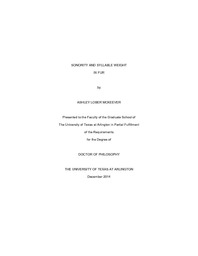
ATTENTION: The works hosted here are being migrated to a new repository that will consolidate resources, improve discoverability, and better show UTA's research impact on the global community. We will update authors as the migration progresses. Please see MavMatrix for more information.
Show simple item record
| dc.contributor.author | Mckeever, Ashley Lober | |
| dc.date.accessioned | 2017-05-31T19:27:30Z | |
| dc.date.available | 2017-05-31T19:27:30Z | |
| dc.date.submitted | January 2014 | |
| dc.identifier.other | DISS-12926 | |
| dc.identifier.uri | http://hdl.handle.net/10106/26699 | |
| dc.description.abstract | This dissertation is a study of sonority and syllable weight and their effects within Fur phonology. It is assumed that a wide range of phenomena are affected by syllable weight and that it is specific to the processes in which it is observed rather than a language universal (Gordon 2007, Fitzgerald 2012, and others). In this study, I show how sonority is used to organize both the syllable and the word in Fur. The Syllable Contact Law (Clements 1990) is particularly important to the organization of words, with non-sonorous codas generally avoided in coda position of heterosyllabic C.C sequences. Using Autosegmental Phonology, this study also presents the lexical tone patterns of Fur and shows how contour tones and complex contour tones are licensed, in part, by the weight of the syllable. In this context, long vowels and sonorous codas are considered heavy (CVV and CVR) and short vowels, whether open or closed with a non-sonorous consonant, are considered light (CV(C)). Moreover, I show how sonority is important in both alliteration and rhyme, with each of these phenomena being important organizing principles in reduplication and in songs. The iambic foot is also shown in this study to be an important organizing tool in reduplication, reflecting how syllable weight is important in this language. For example, bases with the structure of an iambic foot are only allowed to fully copy in reduplication, and with songs, the iambic foot is considered to be the best parse. Beyond showing how sonority and syllable weight are important within Fur phonology, this study also seeks to further the knowledge about this lesser-studied language by describing several phenomena that have been neglected in the language: geminates, contour tone distribution, reduplication, and meter. It is hoped that this study will help broaden the knowledge of the Fur language and that of the Nilo-Saharan language family, while also contributing typologically to the areas of syllable weight and sonority. | |
| dc.description.sponsorship | Fitzgerald, Colleen | |
| dc.language.iso | en | |
| dc.publisher | Linguistics | |
| dc.title | Sonority And Syllable Weight In Fur | |
| dc.type | Ph.D. | |
| dc.contributor.committeeChair | Fitzgerald, Colleen | |
| dc.degree.department | Linguistics | |
| dc.degree.discipline | Linguistics | |
| dc.degree.grantor | University of Texas at Arlington | |
| dc.degree.level | doctoral | |
| dc.degree.name | Ph.D. | |
Files in this item
- Name:
- McKeever_uta_2502D_12926.pdf
- Size:
- 1.008Mb
- Format:
- PDF
This item appears in the following Collection(s)
Show simple item record


